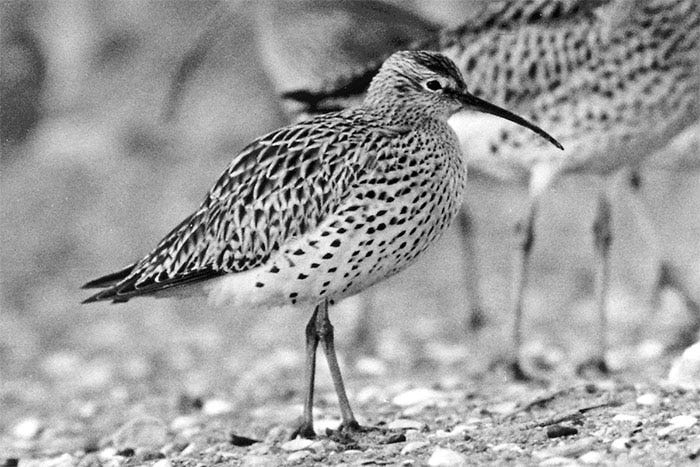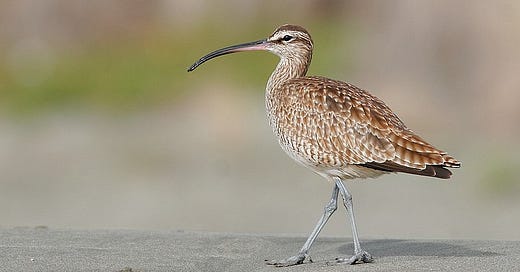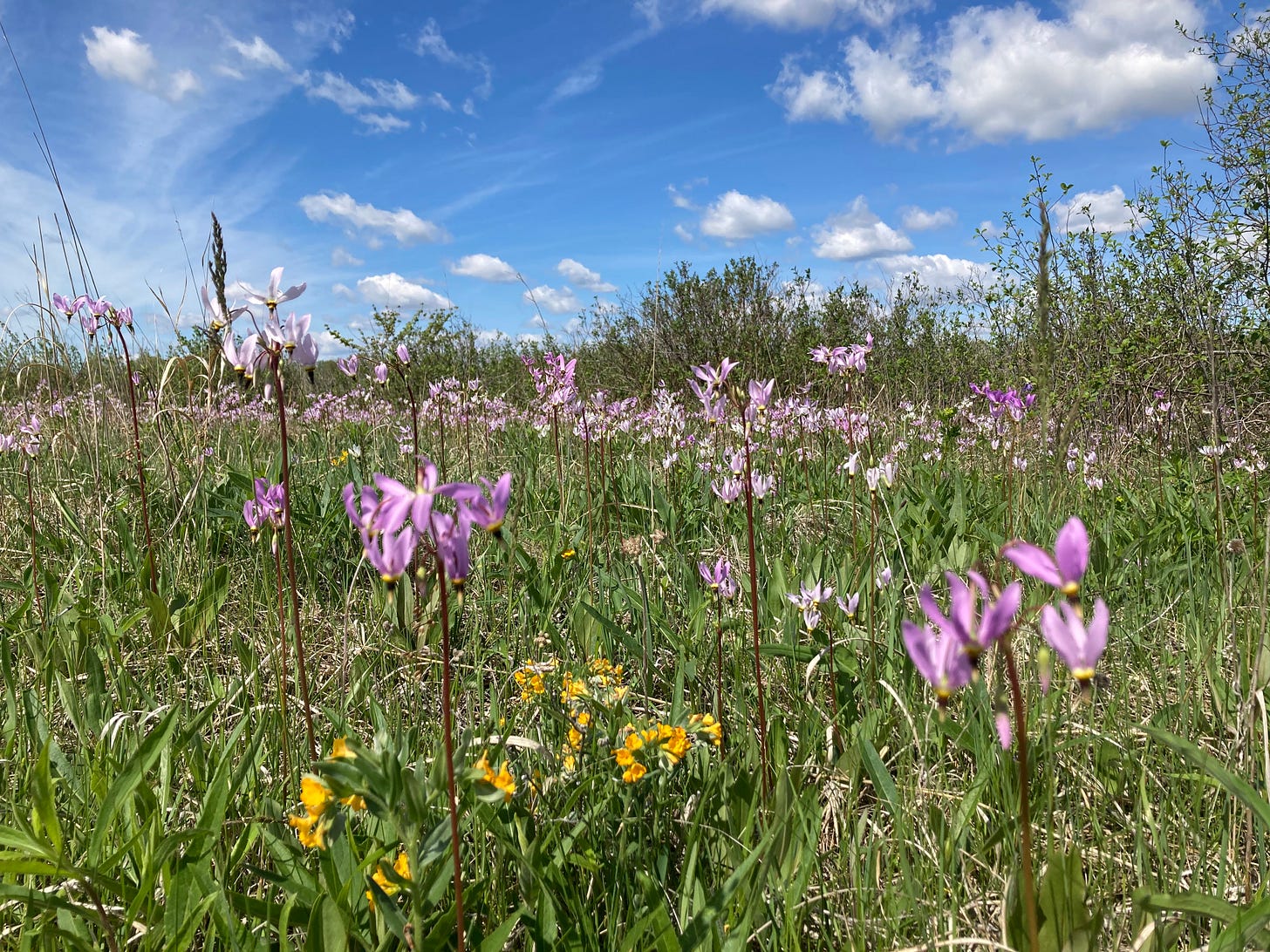Sometimes at the end of May, a late cold front brings wind and rain down from Canada, breaking in the early evening along the shore of Lake Michigan. The squall may pass quickly before dissipating in a golden mist and a rainbow, but it is enough to interrupt the otherwise barely perceptible flow of birds to the north: the tiny aircraft glinting against the afternoon clouds.
Sanderlings may tumble out of the sky, fluttering onto the beach with a patter of dainty black feet amid the raindrops before composing themselves with a ruffle and a folding of wings. They will stay for a few hours before setting sail again.
The passage of the last northbound shorebirds coincides with a moment of suspended animation at the end of spring, before the apogee of summer. It’s an interlude that I try to savor every year, both because of its beauty and because of my abstract anxiety that it is also a microcosm of our era.
Faced with the prospect of ever-longer and sultrier summers, I fear that these may be the halcyon days and decades—a final stretch of relative coolness and tranquility, before the heat turns up for good.
For now though, we still have shorebirds, and we still have spring. With this in mind, a cold, fresh day at the end of May thrills me a little, suggesting that some time is still left on the clock. Birds are continuing their journeys despite the changes that we have wrought—“though much is taken, much abides”—and I feel a need to appreciate them and their persistence.1

This is a strange and expectant juncture of the year: rare, as all times are2. The world is newly foliated, and it is startling to find things obscured that were visible just days ago—the broken statue in the neighbor’s garden, subsumed by irises; or the kite caught all winter in a tree.
It’s nothing like the beginning of May—when the trees are still bare-branched—or the middle, when the buds are crawling with caterpillars and a peacocking procession of brightly-colored buntings, orioles, tanagers, and warblers.
The time for ostentation is over. This is the final act of spring migration, when birds hurry to their summer haunts like late-arriving theater guests, or bats darting caveward at dawn: shadows whispering greetings as the light begins to gleam from beneath the rising curtain of what will soon be long, bright, hot days. It’s easy to miss them, skulking among the fresh leaves or stalking the grassy margin of a flooded field.
For years, I have been hoping to cross paths with one of the most elusive and elegant late spring migrants in the Midwest: the whimbrel, a large brown shorebird with a curved beak and a striped crown. Whimbrels pass briefly through the Great Lakes on their way from the Caribbean to Hudson Bay each spring. A playbook exists for seeing them, though it has yet to work for me:
“If one could be afield daily between 20 and 30 May [along] the Lake Michigan shore … one would stand a good chance of catching a glimpse of this rarity,” Sam Robbins Jr. wrote in Wisconsin Birdlife3. “It is essential to be at the right place at the right time, for this bird’s stopovers are brief.”
Brief, and occasionally spectacular. At Manitowoc on May 22, 1980, a thousand whimbrels paused to rest, taking off again before sunset4. As shorebirds decline worldwide, such spectacles are becoming a thing of the past, but relatively large flocks do still make appearances, sometimes flying along the beach without landing at all.
I’ve been on the beach at the right season several times, and know that on at least one occasion I missed a whimbrel by just a couple of hours. Whimbrels are a bit like shooting stars. If you blink, you’re out of luck.
In some ways, I’m glad that I have not yet seen one in the region. The anticipation is in keeping with the hopeful aura of late spring—the time of graduations, before vacation has started, when the world is wide and full of possibility.
Distractions are plentiful, and one is content to wait, and savor the waiting. In late May, the lakeside meadows at Chiwaukee Prairie are full of the pink-white shuttlecocks of jeweled shooting stars (a wildflower, Dodecatheon meadia), which float over orange-blossomed hoary puccoons and bird’s-foot violets.
The Cardellina warblers which are the namesake of this newsletter—the Canada warbler and Wilson’s warbler—are also most easily seen at this time, when they jump at midges in flowering oaks like outfielders catching pop flies. Chuckling at them, I’ve turned my back to the lake, and whimbrels have probably seized those moments to glide past, unseen.
Whimbrels are curlews, a group of large shorebirds that includes the improbably long-beaked Far Eastern curlew; the bristle-thighed curlew, which links Alaska and the South Pacific; and the Eurasian curlew, which has been the subject of poetry for its beautiful cry.
The curlews’ genus, Numenius, refers to the crescent moon, which matches the curvilinear shape of their beaks—designed, in the whimbrel’s case, to pluck fiddler crabs from their sandy dens5.
As recently as 1963, eight species of curlew graced the uplands, tundras and coastlines of the world. We have caused the extinction of two species (1/4) since then: the Eskimo curlew, which, like the better-known passenger pigeon, was once so common as to be a symbol of American abundance; and the slender-billed curlew, a bird that was one of few to migrate further east-west than north-south, from winter sites in Morocco, Algeria and Tunisia to the steppes of central Russia—near Omsk—for the summer6.

Curlews occupy many of the same habitats as cranes, and face similar conservation challenges. They are often social migrants that have frequently been hunted (the last Eskimo curlew was shot in Barbados), and they depend on a few, very specific sites to fortify them on migrations that span continents.
Researchers discovered only recently, for example, that as many as half of the extant Hudsonian whimbrel population—about 20,000 birds—rest on one tiny sand island in South Carolina in early spring before continuing north. If such places are disturbed or destroyed, there could be serious consequences for the birds.
If and when I finally see a whimbrel on the Great Lakes, it will probably be a surprise at a moment when I am not fully conscious of the fact that I am searching, as often happens7. Seeing one would fulfill a small dream.
But it will also mark the end of the pre-whimbrel era: the rising action will have concluded, and it will be time to move on to other things. The end of spring is bittersweet for the same reason: summer follows—the thrilling climax, after which must come the fall. ◆
Editor’s note: This essay is part of a series delivered monthly via email. If someone forwarded it to you, add your email here to receive future posts directly. If you already subscribe, please consider forwarding it—word of mouth is the best way to boost distribution.
“First of all, it was October, a rare month for boys. Not that all months aren’t rare. But there be bad and good, as the pirates say.” —Ray Bradbury, Something Wicked This Way Comes
Robbins Jr., Samuel D. Wisconsin Birdlife: Population and Distribution, Past & Present. Madison: University of Wisconsin Press, 1991 (265).
Ibid.
Skeel, M. A. and E. P. Mallory (2020). Whimbrel (Numenius phaeopus), Version 1.0. In Birds of the World (S. M. Billerman, Editor). Cornell Lab of Ornithology, Ithaca, NY, USA. https://doi.org/10.2173/bow.whimbr.01
Van Gils, J., P. Wiersma, G. M. Kirwan, and C. J. Sharpe (2020). Slender-billed Curlew (Numenius tenuirostris), Version 1.0. In Birds of the World (J. del Hoyo, A. Elliott, J. Sargatal, D. A. Christie, and E. de Juana, Editors). Cornell Lab of Ornithology, Ithaca, NY, USA. https://doi.org/10.2173/bow.slbcur.01
“She was watching the clock, on the look-out for Anna every minute, but, as often happens, missed the moment when her visitor arrived and did not hear the bell.” —Leo Tolstoy, Anna Karenina, Ch. 19






